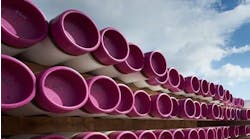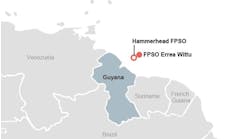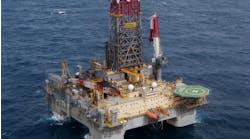Rystad Energy: Suriname set for exploration surge
The Guyana-Suriname basin has seen significant activity in recent years, with Guyana alone unearthing more than 13 billion barrels of oil equivalent (boe) of discovered volumes in the past decade.
As operators in offshore Guyana continue to explore and develop its resources, the focus on its coastal neighbor, Suriname, is growing.
Rystad Energy analysis forecasts that at least 10 wells will be drilled offshore Suriname this year and next combined, driving significant investment and production.
Investment in Suriname’s oil and gas sector has been steadily gaining traction, with upstream spending increasing from $348 million in 2020 to $514 million last year, says Rystad Energy.
The consulting firm forecasts capital investments in Suriname’s upstream sector to reach $9.5 billion between this year and 2027, driven largely by ongoing development of the TotalEnergies-operated GranMorgu project and planned exploration campaigns.
Another milestone project that stands out is the Araku Deep-1 well, Shell’s first of four wells set to spud or to begin drilling operations later this year. A discovery at the well could de-risk deeper plays and provide better clarity around future drilling plans – which would constitute a significant boon for Suriname as it looks to court foreign investment to fund future offshore projects.
Staatsolie, Suriname’s national oil company, is also well positioned to benefit, says Rystad Energy, holding a 20% stake in the development of the Araku Deep-1 well.
Major energies
Shell, TotalEnergies and Chevron are leading exploration efforts in Suriname, aiming to increase the country’s total resources, which currently stands at 2.2 billion boe recoverable. This ranks second among emerging exploration areas only to Namibia, which together with Turkiye has contributed 15.5 billion boe in new oil and gas resources since 2020, representing 35% of global discoveries during that period.
Additionally, the similarities in petroleum systems between Suriname and Guyana are expected to play a key role in driving significant exploration activity in the region.
Palzor Shenga, Vice President, Upstream Research at Rystad Energy, observed that: “Between the two countries, Guyana has traditionally been the focal point of oil exploration, but Suriname is increasingly gaining attention as a prime target, particularly in Block 58. The similarities in petroleum systems between the coastal neighbors are expected to play a pivotal role in the decision-making process of majors, which are drawn to the geological similarities, proven exploration success and Suriname’s active courting of foreign investment, creating a favorable environment for exploration and production. There is every reason for assets in Suriname to be capable of generating healthy cash flows despite operating in a high-risk and relatively unexplored environment.”
Deep and shallow water
Suriname’s upstream potential will be unlocked through both deepwater and shallow-water exploration, says Rystad Energy. A key development is the GranMorgu project, which includes the Sapakara South and Krabdagu fields and which is estimated to recover around 700 million boe. This project, which is expected to come online in 2028, is set to mark Suriname’s first deepwater offshore oil production, utilizing an FPSO vessel with oil production capacity of up to 220,000 barrels per day. The FPSO will also feature 2 million barrels of crude storage and a gas treatment capacity of up to 500 million cubic feet per day. Designed with an all-electric drive platform, the project will focus on minimizing emissions, with zero routine flaring and full re-injection of associated gas into the reservoirs.
Timelines improving
Timelines have also improved greatly for projects in the Guyana-Suriname basin. In addition to the Liza-1 well on the Stabroek Block, the first major oil discovery offshore Guyana, which was fast-tracked to production within four years of its discovery, other projects in the basin have taken or will take around six years from discovery to the start of production. This achievement highlights a significant reduction in lead time for offshore deepwater projects and demonstrates the ability and willingness of global explorers to fast-track prominent, economically recoverable reserves.
3D seismic survey
Malaysian state oil and gas giant Petronas is also active in Suriname’s upstream exploration. The company is currently conducting a 3D seismic survey in Block 63 and Block 52, covering an area of 6,042 square kilometers. This survey, which is being carried out by the Shearwater-owned vessel Amazon Warrior, began in December last year and is expected to take approximately 150 days. The primary goal of the survey is to delineate the Ironman prospect ahead of exploration drilling, forming part of a committed work program that includes a second exploration phase set to begin in January 2027.
Petronas is focused on developing its discoveries in Block 52, where recoverable resources are estimated by Rystad Energy to exceed 500 million boe. These discoveries include Sloanea-1 (2020), Roystonea-1 (2023) and Fusaea-1 (2024). However, Petronas must either continue the project independently or seek a new partner, following ExxonMobil’s exit from its 50% stake in the block last year. A successful exploration campaign and a significant discovery could accelerate development plans and attract potential partners to the project.
Subscribe to Offshore's YouTube channel for offshore energy industry updates, trending technologies, in-depth explanations and executive insights.





